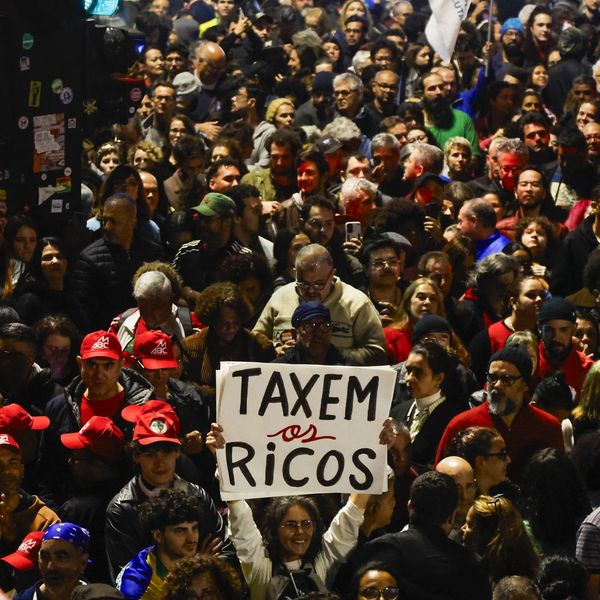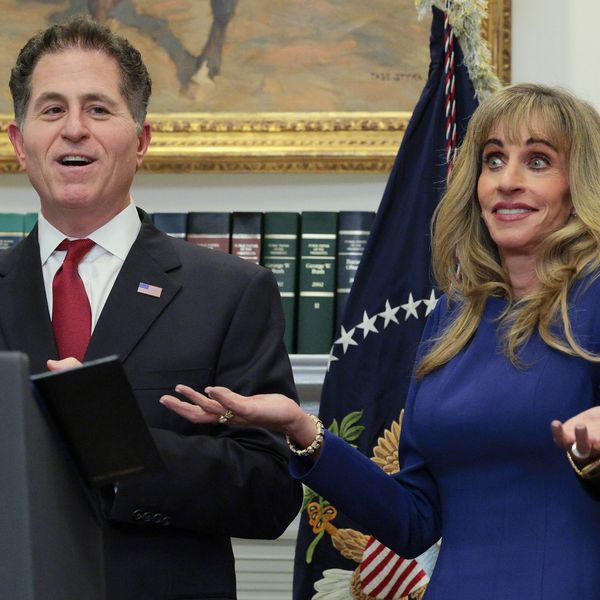
People participate in a "March on Billionaires" event on July 17, 2020 in New York City. According to data from the Organization for Economic Cooperation and Development, income inequality in the United States is the highest of all G7 nations. (Photo: Spencer Platt/Getty Images)
Analysis Shows Richest 10% Now Own Nearly 70% of All Household Wealth in US
As 2020 came to a close, the bottom 50% of earners controlled just 2% of U.S. wealth.
More than a year after the coronavirus pandemic and the corresponding economic crisis began, a new analysis out Wednesday shows that as 2020 ended, the richest 10% of Americans possessed just under 70% of the nation's household wealth.
According to the report by financial news website Finbold, which looked at the final quarter of 2020, that top bracket of rich individuals accounted for 69.2% of wealth, including real estate, bank accounts, stocks, and other assets.
Nearly half of those assets are concentrated in the wealth of the top 1%, who own a combined $38.91 trillion. Nearly $47 trillion is owned by the remaining top 9% of rich households.
The bottom 50% of earners, meanwhile, control a combined $2.49 trillion--or 2% of U.S. household wealth.
\u201cThe richest 1% in the US control 31.4% of all household wealth.\n\nThe richest 10% control 69.2% of all household wealth.\n\nThe least wealthy 50% control .. 2% of the wealth.\n\nSource: @finbold\u201d— scott budman (@scott budman) 1619018505
The analysis comes after a year in which the gap between the wealthiest Americans--who derive far more of their wealth from the stock market than the working poor and middle class families--came into stark relief. Markets quickly rebounded after the initial shock of the pandemic, even as more than one million Americans were filing unemployment claims each week at the end of 2020.
"The lower class mainly comprises service workers who don't have the pleasure of working from home. This group comprised the massive job cuts witnessed amid the pandemic." --Oliver Scott, Finbold
As the New York Times reported in January, the top 10% of American households control 84% of all Wall Street portfolios' value, while the bottom 50% of earners are more likely to derive their wealth from work--in a country where incomes for most workers have barely grown in four decades, and the federal minimum wage of $7.25 per hour has remained stagnant since 2009.
As the pandemic gripped the U.S. and forced hundreds of thousands of restaurants and other businesses to close in 2020, Finbold's report noted that low-income workers faced furloughs and layoffs while their counterparts in the middle- and upper income brackets were more likely to keep working while avoiding exposure to Covid-19.
"The lower class mainly comprises service workers who don't have the pleasure of working from home," Finbold editor-in-chief Oliver Scott wrote. "This group comprised the massive job cuts witnessed amid the pandemic. The middle-class individuals were able to work from home while retaining their income."
The analysis shows a "staggering difference" between the wealthiest Americans and lower-income Americans which has grown in the last three decades, Scott wrote. Between the fourth quarter of 1990 and the fourth quarter of 2020, the collective wealth of the top 1% grew by 675%, from $5.02 trillion to nearly $39 trillion.
Meanwhile, the wealth of the bottom 50% grew by less than $1 trillion to just $2.49 trillion over 30 years.
An Urgent Message From Our Co-Founder
Dear Common Dreams reader, The U.S. is on a fast track to authoritarianism like nothing I've ever seen. Meanwhile, corporate news outlets are utterly capitulating to Trump, twisting their coverage to avoid drawing his ire while lining up to stuff cash in his pockets. That's why I believe that Common Dreams is doing the best and most consequential reporting that we've ever done. Our small but mighty team is a progressive reporting powerhouse, covering the news every day that the corporate media never will. Our mission has always been simple: To inform. To inspire. And to ignite change for the common good. Now here's the key piece that I want all our readers to understand: None of this would be possible without your financial support. That's not just some fundraising cliche. It's the absolute and literal truth. We don't accept corporate advertising and never will. We don't have a paywall because we don't think people should be blocked from critical news based on their ability to pay. Everything we do is funded by the donations of readers like you. Will you donate now to help power the nonprofit, independent reporting of Common Dreams? Thank you for being a vital member of our community. Together, we can keep independent journalism alive when it’s needed most. - Craig Brown, Co-founder |
More than a year after the coronavirus pandemic and the corresponding economic crisis began, a new analysis out Wednesday shows that as 2020 ended, the richest 10% of Americans possessed just under 70% of the nation's household wealth.
According to the report by financial news website Finbold, which looked at the final quarter of 2020, that top bracket of rich individuals accounted for 69.2% of wealth, including real estate, bank accounts, stocks, and other assets.
Nearly half of those assets are concentrated in the wealth of the top 1%, who own a combined $38.91 trillion. Nearly $47 trillion is owned by the remaining top 9% of rich households.
The bottom 50% of earners, meanwhile, control a combined $2.49 trillion--or 2% of U.S. household wealth.
\u201cThe richest 1% in the US control 31.4% of all household wealth.\n\nThe richest 10% control 69.2% of all household wealth.\n\nThe least wealthy 50% control .. 2% of the wealth.\n\nSource: @finbold\u201d— scott budman (@scott budman) 1619018505
The analysis comes after a year in which the gap between the wealthiest Americans--who derive far more of their wealth from the stock market than the working poor and middle class families--came into stark relief. Markets quickly rebounded after the initial shock of the pandemic, even as more than one million Americans were filing unemployment claims each week at the end of 2020.
"The lower class mainly comprises service workers who don't have the pleasure of working from home. This group comprised the massive job cuts witnessed amid the pandemic." --Oliver Scott, Finbold
As the New York Times reported in January, the top 10% of American households control 84% of all Wall Street portfolios' value, while the bottom 50% of earners are more likely to derive their wealth from work--in a country where incomes for most workers have barely grown in four decades, and the federal minimum wage of $7.25 per hour has remained stagnant since 2009.
As the pandemic gripped the U.S. and forced hundreds of thousands of restaurants and other businesses to close in 2020, Finbold's report noted that low-income workers faced furloughs and layoffs while their counterparts in the middle- and upper income brackets were more likely to keep working while avoiding exposure to Covid-19.
"The lower class mainly comprises service workers who don't have the pleasure of working from home," Finbold editor-in-chief Oliver Scott wrote. "This group comprised the massive job cuts witnessed amid the pandemic. The middle-class individuals were able to work from home while retaining their income."
The analysis shows a "staggering difference" between the wealthiest Americans and lower-income Americans which has grown in the last three decades, Scott wrote. Between the fourth quarter of 1990 and the fourth quarter of 2020, the collective wealth of the top 1% grew by 675%, from $5.02 trillion to nearly $39 trillion.
Meanwhile, the wealth of the bottom 50% grew by less than $1 trillion to just $2.49 trillion over 30 years.
More than a year after the coronavirus pandemic and the corresponding economic crisis began, a new analysis out Wednesday shows that as 2020 ended, the richest 10% of Americans possessed just under 70% of the nation's household wealth.
According to the report by financial news website Finbold, which looked at the final quarter of 2020, that top bracket of rich individuals accounted for 69.2% of wealth, including real estate, bank accounts, stocks, and other assets.
Nearly half of those assets are concentrated in the wealth of the top 1%, who own a combined $38.91 trillion. Nearly $47 trillion is owned by the remaining top 9% of rich households.
The bottom 50% of earners, meanwhile, control a combined $2.49 trillion--or 2% of U.S. household wealth.
\u201cThe richest 1% in the US control 31.4% of all household wealth.\n\nThe richest 10% control 69.2% of all household wealth.\n\nThe least wealthy 50% control .. 2% of the wealth.\n\nSource: @finbold\u201d— scott budman (@scott budman) 1619018505
The analysis comes after a year in which the gap between the wealthiest Americans--who derive far more of their wealth from the stock market than the working poor and middle class families--came into stark relief. Markets quickly rebounded after the initial shock of the pandemic, even as more than one million Americans were filing unemployment claims each week at the end of 2020.
"The lower class mainly comprises service workers who don't have the pleasure of working from home. This group comprised the massive job cuts witnessed amid the pandemic." --Oliver Scott, Finbold
As the New York Times reported in January, the top 10% of American households control 84% of all Wall Street portfolios' value, while the bottom 50% of earners are more likely to derive their wealth from work--in a country where incomes for most workers have barely grown in four decades, and the federal minimum wage of $7.25 per hour has remained stagnant since 2009.
As the pandemic gripped the U.S. and forced hundreds of thousands of restaurants and other businesses to close in 2020, Finbold's report noted that low-income workers faced furloughs and layoffs while their counterparts in the middle- and upper income brackets were more likely to keep working while avoiding exposure to Covid-19.
"The lower class mainly comprises service workers who don't have the pleasure of working from home," Finbold editor-in-chief Oliver Scott wrote. "This group comprised the massive job cuts witnessed amid the pandemic. The middle-class individuals were able to work from home while retaining their income."
The analysis shows a "staggering difference" between the wealthiest Americans and lower-income Americans which has grown in the last three decades, Scott wrote. Between the fourth quarter of 1990 and the fourth quarter of 2020, the collective wealth of the top 1% grew by 675%, from $5.02 trillion to nearly $39 trillion.
Meanwhile, the wealth of the bottom 50% grew by less than $1 trillion to just $2.49 trillion over 30 years.

